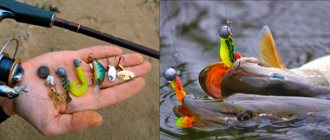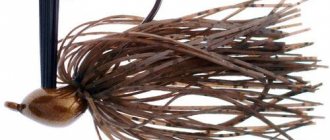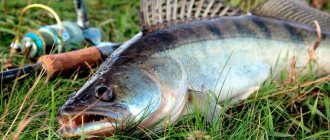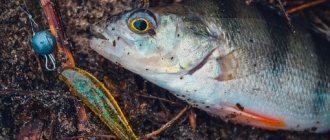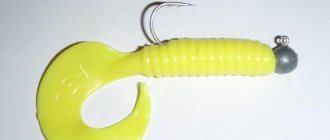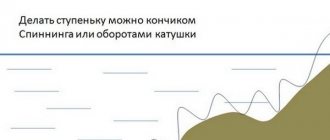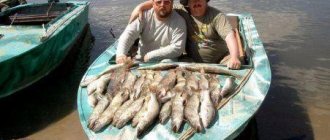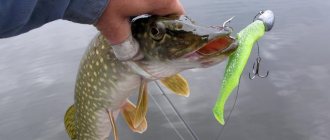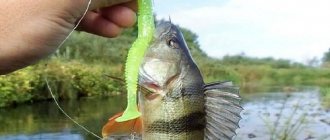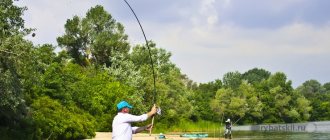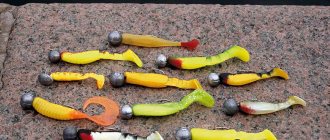It would seem that a lot has been written about spinning jig fishing, but this is far from the case. There are a large number of nuances that, despite the abundance of publications on this topic in various fishing media, are left unattended. In this article I will try to reveal them.
Only at first glance, a spinning jig is a primitive type of fishing: throw the bait and lead it with a step. Two or three turns of the reel handle - a pause. You can fall asleep... If you make casts anyhow and monotonously jig, then most likely there will be no positive result. But with a thoughtful and balanced approach to jig fishing, success will not be long in coming.
Finding fish when fishing with a jig
The first thing you should pay attention to when fishing with a jig in a new area is the banks of the river. Even if the coast is flat and monotonous, changes in the underwater relief can be determined by the edge of the coastline. Various small toes can tell us that under water there is a possible turn or bend in the shoreline where a predator can live. Even if such places are found in some extended area with a silted and gently sloping shore, you can count on a catch from them. It is especially good to look for such “points” when the water level is low, when it has moved at least a meter or two from the shore. If possible, you should stand on such toes not in the very center of this small “tongue”, but a little further upstream. This is necessary so that when placing the bait it does not go too far downstream, but directly crosses the spit itself on which we are fishing.
Even when we fish in areas that are familiar to us, it is better to stop at all such points, and not between them. This is confirmed by the fact that when fishing, spinners often move along the shore in small groups, and there are often situations when one fishes, and the rest act as extras. At the same time, everyone has the same jig bait and fishing line, and everyone tries to throw it in one place, but only one catches. In this case, many begin to blame luck or come up with some other explanations.
And the reason in most cases is simple - the one who successfully fishes with a jig stands on the shore with reference to the microrelief, and the rest stand nearby. When the fish is active, everyone bites, and when there is no increased activity, only the one who holds the bait directly under the nose of the fish catches. You should also watch your step in areas with varied and interesting terrain. A lot depends on the accuracy of the jig when fishing.
We continue fishing.
If there was no bite at the time of the fall, the jig sinks to the bottom. The tip of the spinning rod is slightly straightened - only the force of the water flow acts on it.
You make two slow turns with the reel handle. Your job is to slowly lift the jig off the bottom. As soon as you start to rotate the reel handle, the spinning rod will bend again, the jig will come off the bottom and will act on the spinning rod again. After completing the revolutions of the reel handle, you begin counting: one hundred one, one hundred two, one hundred three. The jig should fall to the bottom - the tip of the spinning rod will straighten slightly again. Relatively speaking, the jig follows some kind of trajectory near the bottom, reminiscent of a wave. Let's call this trajectory a step, and the wiring based on this step will be called stepped. To catch pike perch, you must master it and try to make your “steps” similar to those described above.
I highlight the main point - the pause after rewinding is 2-3 seconds. Observing this condition, you try not to raise the jig high above the bottom with your wiring, because pike perch attacks about a meter from the bottom. Most bites occur precisely during the phase when the jig falls to the bottom after the reeling stops. I will tell you later how they manifest themselves.
For more obvious control over the behavior of the jig during retrieving, you need a fast-action spinning rod, that is, one in which the upper third of the blank bends under load. As a beginner, you simply need this spinning rod. I won’t describe the gear in more detail, I’m talking about something else. Your wiring should ideally look like this: casting, the jig touching the surface of the water, the jig falling to the bottom with the line handler closed, the tip of the spinning rod bends and trembles slightly at the moment of the fall (if the spinning rod is of good quality, its tip shows that your bait is “playing” in water). Then the jig falls to the bottom, you make 1.5-2 turns with the reel handle, pause for 2-3 seconds. After the jig falls to the bottom, freeze for a second and start the step again. They should follow one after another, monotonous, similar to each other. I understand that this is boring, you’re probably tired of just the description of the process, but otherwise you’ll catch pike perch by accident. Let me remind you that I am talking about autumn pike perch on the river. However, pike perch can take such a line at any time of the year, on any body of water.
Next, I will tell you how to achieve this “basic” wiring in specific fishing conditions, which are very different from ideal. Let's start with the simplest.
I'm on the river. Mid October. I'm sitting in a boat, facing the current. Under the boat there is a flat river hole, it stretches about 300 meters and is located along the right, steep bank, with old trees fallen into the water. On the left is shallow water, with a clearly defined longitudinal drop into the depths, into a hole. That is, this is a typical pit, of which there are a great many on our rivers. I want to catch pike perch in this hole. I know that he is here. There are exits for him to feed, the location of these exits does not bother me - during the day I will catch him anyway. It’s better for me to start with fishing the dump from the shallows to depth, but I’ll talk about this another time, because Wiring the jig here is technically more complex. Therefore, I will cast strictly with the flow. My boat is anchored at the beginning of the hole. I don't know what jig head weight to use to do a "basic" retrieve.
That's why I have jig heads of different weights, from light to heavy - weighing 40 g. I choose a head weighing 20 g and put a 10-centimeter vibrotail on it. I cast as far as possible downstream. The jig begins to fall to the bottom. Now the tip of the spinning rod is straightened, I start retrieving. Two turns of the handle, a pause, 7 seconds pass, and the jig touches the bottom again. I didn't get the wiring I needed. The weight of the jig is too light. Then I set the jig heavier, say 25 g, and again cast as far as possible. The jig falls to the bottom again, but faster than in the first case, because the head is heavier. I'm starting the wiring. Reeling, pause - the jig drags along the bottom, reeling again, pause - and again there is no play. I continue and at some point, at some “step” there is a second pause, at the next “step” there are 2-3 and several steps become “basic”. I am happy with the found weight of the jig, continue retrieving - after all, it’s still a long way to the boat, I take a few more steps and the pause begins to grow, increasing to 5 or more seconds. The jig has stopped falling to the bottom and hangs in the water column.
Times and exits
Now let's talk about how much time should be spent at the point, waiting for the predator to come out. If we are using a jig to break through a new section of the river for ourselves, then we shouldn’t stay in one place for a long time, it’s enough to make no more than five casts from one place, and if the fish doesn’t show itself in any way, then we should move further. How far? This depends on the characteristics of the coastal microrelief. You should stand at the next point in connection with it. Usually this distance is about 10–20 m. If there are no bites in the new place, you should move further until we find fish.
Very often, with such jig fishing tactics, the so-called “first cast rule” is triggered. Many people think that fish are caught on the first cast either by accident or due to a frenzied bite. However, this is not the case. With proper positioning of the spinning rod on the shore and correct presentation of the bait, this rule becomes a system regardless of the current activity of the fish and the will of fortune.
Why is it necessary to constantly move and look for fish, and not stand for a long time in one place, waiting for the exit? The answer is simple. A predator that is active, as a rule, also does not stay in one place for a long time, but moves along edges, ditches and other shelters in search of prey. And therefore, in order to increase the chances of meeting a jig bait with a fish, you yourself need to constantly move.
In addition, constant movement, even in some limited section of the river, allows us to get a more detailed idea of the nature and features of the relief of the place we are fishing.
Many argue that such a number of casts from one point is not enough to study the terrain in the fishing area and catch fish, but this is far from true: if a predator is in the place where you are fishing, it manifests itself already in the first few casts. And moving often, we cover a much larger area with casting and wiring.
Everyone knows that fish have a daily activity schedule, therefore, when fishing with a jig, it should be taken into account. Typically, the time from dawn to midday is the most productive, followed by a small burst of daytime activity and an evening out. Accordingly, it is advisable to search for fish during these hours, and during a decline in activity it is best to linger and fish in more detail the promising places found.
Changing jig fishing tactics
Fishing turned out to be sporty. Only a few small-sized perches were on the kukan, the small things were sent back to the river element. I decided to change the wiring and increase the pauses; this, of course, could lead to the bait falling into the grass, but the likelihood of larger perches biting increased. This tactic produced an unexpected result. During the pause, Tsunik was attacked. The clear pressure, not typical for a perch bite, was even a little surprising. I hooked and felt a pleasant heaviness. Almost a kilogram of pike perch was hooked.
It’s nice to fight with such an opponent; this is not a palm perch. It is very unusual that the pike perch bit on the Tsunika; he is not a big fan of silicone worms. So unexpectedly my fishing day ended. Enough for a couple of frying pans, you can get ready to go home.
It turns out that even pike perch can be caught in the grass under the shore using a “worm” bait. Fishing is always full of surprises, and that’s what makes it so wonderful. NHNCH.
Fishing with a feeder on the current - places, bait, comfort and bait
Fishing on the Neman
Onboard bream fishing on the reservoir
Posting a jig bait
If you think that jig wiring is monotonous, then you are a little mistaken. The number of revolutions, reeling speed, height and sharpness of the jig bait’s separation from the bottom should constantly change. For example, you are fishing in a place with complex and varied terrain: on release, the bait falls on a dump on the opposite bank, then there is a channel ditch, then a slight rise and a coastal ditch. In such cases, it is recommended to do a large amount in small places.
turns the reel handle at high speed, but it’s better to do it differently. Do not spin the reel at breakneck speed, but make no more than three leisurely turns of the reel. This is necessary in order not to miss the fall into depth. If we make 5-6 revolutions at a fast pace, we will simply miss it. Further, the jig bait begins to fall from the dump. This can be clearly felt by the sharp increase in the time the jig falls to the bottom. At this moment, it is better not to make sudden movements with the bait, reduce the number of revolutions to 1-2 and during a pause, release the line using a spinning rod, tilting it towards the water. But the line must nevertheless remain constantly taut, since a fish bite is most likely at this time. Why do you need to lower the tip of the spinning rod to the water? The answers to this question are quite simple: the jig bait falls along a more vertical trajectory, and changes in relief are determined best this way.
Next begins a section with a fairly uniform depth, where the rotation speed of the coil can be increased. Then, we begin to feel the increased resistance of the retrieve - this means that the jig has come close to the edge - here it is better to speed up the pace and raise the spinning rod as high as possible in order to prevent snagging. Bites at this stage of wiring also happen quite often, but at a time when the predator is highly active. Although there are exceptions. So, we raised the jig to the underwater hump, now we should slow down the speed again and reduce the step of the stepped retrieve. Pike bites are most likely in the coastal ditch. In this place, the jig bait should be cast very slowly; the reel should make no more than two turns. When approaching the coastal drop, the speed of the retrieve must be kept quite slow. Only when we begin to feel that the bait has been dragged to the dump can we begin to reel it in.
Jig "on fingers"
Photo by the author
Many hunters I know are familiar with spinning fishing only on lakes. That is, the morning and evening were spent fishing for ducks, and during the day you can catch pike and perch. But such a popular spinning fishing as jig passes them by. I would like to introduce the uninitiated to this type of fishing. I will try to explain what step wiring is. Today I’ll tell you about some of the features when fishing in the current and deliberately will not touch on the “materials” - spinning rods, reels and fishing lines, with the exception of those characteristics that play a decisive role in a particular case.
Watch where you throw it!
For fishing on the river, depending on the strength of the current and depth, loads of different weights are used. I would recommend the following set: 16, 18, 20, 23, 26, 30, 35 grams. If you have at least a rough idea of what kind of cargo to place in a particular place, then place it. Next, cast the bait across the current. Try to cast so that the bait flies more horizontally, so that a huge loop of fishing line does not fly out. Try to remember the casting direction as accurately as possible. For example, I come up with a game as if I were bombing the opposite shore or playing a “sea battle”. This helps me, when I bite, to remember exactly the direction that I “bombed” just now.
At the moment the bait touches the water, close the line handle (sometimes you can slightly slow down the flow of the line with your index finger on the side of the reel spool), select the slack and start counting, approximately in seconds. This will help you determine the depth and then evaluate another place that you move to later - whether it is deeper there or shallower. You tilt the spinning rod forward towards the line exiting the water at about 45 degrees from the vertical and, counting to yourself, wait for the moment the load touches the bottom. This will be noticeable by the “nod” of the tip of the spinning rod; at the moment the load falls, it is slightly curved, and when the load contacts the bottom, it “plays back” back. If the current is not strong and the load is heavy (25-30 g), then you can feel the bottom touching the bottom with your hand through the spinning rod (although a lot depends on the sensitivity of the spinning rod), and a little later you can see how the line sag. At this moment you begin rewinding - usually 2-3 turns of the reel. Pause. The bait falls again, wait for contact with the bottom and again count how many seconds it will take it to fall - i.e. do the usual step wiring.
If you can control the bottom using line slack, keep the spinning rod in line with the line while also watching the tip of the spinning rod. In this case, it is advisable to use fluorescently colored braiding, because it is more noticeable against the background of dark water or landscape on the opposite shore. If the current is strong, then the line will not sag, and it is better to control the wiring at the tip of the spinning rod. In this case, you can not keep the spinning rod in line with the fishing line, but position it at an angle in the horizontal plane or even parallel to the shore (to the left or to the right - whichever is more convenient for you). Relative to the vertical, the tip should be kept at 45 degrees - the line will come out of the tulip of the spinning rod almost at a right angle, which noticeably “loads” the tip and allows you to more clearly track the contact with the bottom. Next, bring the bait all the way to the shore. In this way, you can roughly determine the bottom topography.
Calculating the bottom relief
If you constantly make 3 turns of the reel, and the bait suddenly begins to fall for 5-6 seconds instead of 2-3, then it means you have found the edge - the load falls along the slope into the hole. A situation is possible when you do not feel a clear contact with the bottom, and the bait suddenly begins to drag along the bottom - this is expressed in frequent twitching of the tip, in such “crushing”. In this situation, you can either put a lighter load, or change the place - it’s small here. Or you can also do this “trick”: cast it a little lower downstream, about 30 degrees from the perpendicular. The current will tighten the line, and the bait can work normally even with a heavy load. In addition, in shallow places it is useful to raise the tip of the spinning rod up as high as possible - the vertical component during reeling will increase, which, in turn, will slightly increase the time the bait falls. If, on the contrary, the load chosen for a given location is lighter than necessary, it should be thrown higher upstream, but the reel handle will have to be turned faster, since the speed of the current is added to the reeling speed.
Another “unpleasant” situation: the main (and quite strong) current passes 50-60 meters from the shore, and the return current is closer to you (usually the return current is noticeably weaker and the depth is shallower). Most often, bites occur at the border of the streams, as there is a sharp drop into depth. But you have to cast it beyond this border, onto the main current. As a result, the line bends in the shape of the letter “S” - half of the line near the bait is blown in one direction, and the other, closer to the shore, in the other. This makes it extremely difficult to control the behavior of the jig bait. However, there is a way to improve the sensitivity of the tackle: firstly, the weight should be set based on fishing on the main stream. Secondly, you just need to throw the boundary of the jets a little and, raising the spinning rod high (so that as little fishing line as possible is in the water on the reverse current), make a retrieve through the zone of calm water, along the edge, and then quickly reel in the fishing line if there is no bite.
This place on the river is quite interesting; it is more often found at river bends under a steep bank. Of course, there are differences in the bottom topography - either instead of a drop there is an underwater spit, or on the main stream it is shallower, and deeper under the shore. It is better to try to catch the boundary of the jets from different points. Usually there is some kind of cape upstream of the river, from which you can try to move the bait almost parallel to the shore along the edge of the streams.
In still water
In still water, retrieving is much easier - there is no influence of the current on the bait and line, which greatly interferes with controlling the position of the bait relative to the bottom. Therefore, in the absence of a current, there are much more opportunities to “read” the bottom of the reservoir. Since the weights used are lighter (usually no more than 12-14 g), and the fishing lines are thinner, you can take a spinning rod of a lighter class. Its sensitivity will allow you to more clearly track the touch of the bait on the bottom, stones, clay ledges, etc. In still water, it is very important to keep a second countdown of the fall of the bait in order to clearly understand the bottom topography. The current does not interfere here, and you can accurately determine a hole or drop. Casting and retrieving are not much different from fishing in the current. Rather, even wiring in a “stand-up position” allows more “liberties” - you can cast it to any place, and hold the spinning rod based on how convenient it is for you (however, not forgetting about the convenience of controlling the tip of the spinning rod or the sag of the fishing line) or so that the sun It didn't blind my eyes.
You should also pay attention to the different types of fishing with a rod rather than a reel. At the same time, we must work with the tip of the spinning rod like a whip on a winter fishing rod and add vibrations to the bait during the fall. Here you can twitch and drag lightly along the bottom before starting the “step”, and try to fish at different depths using an accurate count as you fall. In still water, most often the fish stands near snags, so it is not a bad idea to have non-snaking baits with you (foam rubber fish with pressed double stings or a jig head with a hook sting hidden in the bait). In such places, bites occur both before and after snags. When biting before the snags after hooking, you don’t need to force the fish to land, but it’s better to just try to hold it and wait for it to rise a little. Bites after snags are expected after you carefully drag the bait through the snags and it begins to fall again.
Why didn’t we talk about snags in the section about fishing on currents? The fact is that it is easiest to distinguish a fish bite from a hook (or the bait touching an obstacle) in a body of water without a current. Standing water also allows you to fish a snag from different sides. This is achieved by precise casts to the left, right or straight through the snag. To do this, as soon as you have found something interesting at the bottom, start making the next casts, guided by your own “bearings” on the opposite bank.
Fighting the wind
The wind makes its own adjustments to fishing, and the stronger it is, the more difficult it is to control the retrieve. Especially in a body of water with a strong current. Perhaps the most unfavorable option is a side wind that blows in the direction of the current. The flow of water carries away the bait, tensions the fishing line, and in addition, the surface part of the fishing line also receives its share of the load, coinciding with the current. The jig literally “flies” through the fishing zone, and you are unlikely to have time to feel the contact of the bait with the bottom. A strong side wind is also bad because when casting, a huge loop of fishing line is blown out, which can even fall on trees or bushes growing on the shore. After splashing down the spinner, you must immediately begin to quickly rotate the reel, picking up the slack so that the loop of the fishing line does not have time to fall to the surface of the water. In the case of wind against the current, this is not so scary, but when the direction of the wind coincides with the current, the flow of water will quickly pick up the loop of the fishing line and tighten it so that the bait will immediately be thrown under the shore, and you will still be idle turning the reel. To at least somehow compensate for the influence of the wind, cast higher upwind, trying to send the bait at an angle of no more than 30° to the surface of the water.
Headwind (as well as from behind) has the least effect on wiring. The only thing you need to pay attention to is that the headwind noticeably slows down the flight of the bait when casting, greatly shortening it. If you need to “break through” the headwind and make a long cast, you need to use the thinnest possible braid and a bait with a heavier load and good aerodynamic characteristics - a small tailless “foam rubber” will be much more appropriate than a large vibrating tail or some kind of “octopus”. And in general, when fishing in the wind, you almost always have to use heavier weights than are necessary in this place in calm weather, a thinner cord and a less sailing bait. With a tailwind, everything is much simpler - the bait easily flies very far, so you don’t have to put much effort when casting.
Everything said above related mainly to casting. Now let’s move on directly to wiring, or more precisely to those measures that allow you to carry out step-by-step wiring while maintaining the feeling of contact of the bait with the bottom.
Tracking the bait using the sag of the fishing line is almost impossible to do even in light winds. All your attention should be focused on the tip of the spinning rod and the “recoil” in your hand. Before starting reeling, it is advisable to submerge the fishing line and hold the spinning rod relative to the wind (and also relative to the coastline and horizon) so as to find a compromise between the convenience of the spinner himself (for example, stand sideways to the wind) and maximum ease of control over the reeling. Do not forget that in order to control the flow, the fishing line should come out of the tulip at an angle of approximately 90°, however, when there is wind, sometimes you have to lower the tip of the spinning rod close to the water in order to minimize the wind pressure on the fishing line.
When fishing with a jig in windy weather, it is good to use a multiplier, or rather, not even the reel itself, but the “finger” fishing method. This method gives maximum sensitivity, regardless of current and wind. Its essence lies in the fact that after casting, the line is passed between the thumb and index finger of the hand that holds the spinning rod directly next to the reel. When using braid, all fish bites, the slightest impacts on the ground and snags are immediately transferred to the hand. Usually the spinning rod for this fishing method is kept in line with the fishing line. Often when there is wind, the spinning angler gives up. It seems to us that without feeling the bottom, we won’t even notice the bites. However, according to my observations, in the wind the fish takes it more boldly than in the calm, so it’s still worth being persistent.
Alexey Kolomiets January 24, 2014 at 14:53
Jig bait
For shore fishing, I use foam fish and small twisters from 2 to 5 inches. In most cases, the optimal twister length is 3 inches. I use weights weighing from 14 to 52 grams, depending on the strength of the current, depth and required casting distance. Moreover, I use weights from 14 to 32 g with 3-inch twisters, and heavier ones with 4-5-inch twisters. This is necessary so that when using larger and more floating baits, the casting range does not decrease.
